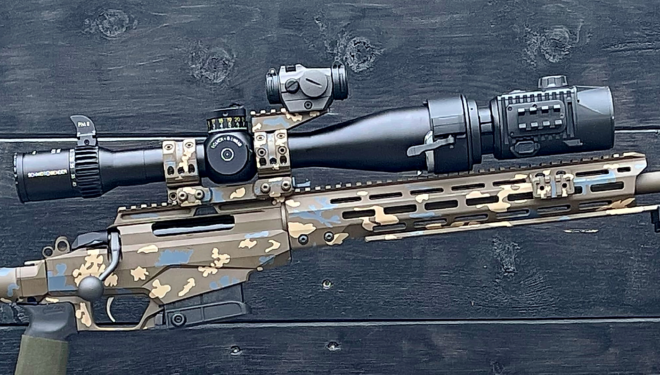This is a review of the Schmidt & Bender 5-45×56 PMII High Power Riflescope. I’ve reviewed almost all of S&B’s PMII riflescopes, and as the “top bird”, the 5-45x holds a special place. It was (and still is) my Holy Grail of riflescopes. The 9-power magnification range makes this optic quite extreme, as you can go from 5 power up to 45 power. Most of the time I use it around 20-30 power, but I love to have the ability to spot, observe – and engage – targets up to 45 power. I’m sure there are some disadvantages, as always within the laws of optics, but I wouldn’t say that stopped me from liking the overall performance.
Schmidt & Bender Riflescopes @ TFB:
- TFB Review: Schmidt & Bender 3-12×50 PMII Scope with Spuhr QD Mount
- TFB Review: Schmidt & Bender 5-20×50 PM II Ultra Short Series
- TFB Review: Schmidt & Bender 3-27×56 PMII High Power Riflescope + Aimpoint ACRO C-1
- TFB Review: Schmidt & Bender 5-25×56 PMII with Long Range Reticle
- POTD: Schmidt & Bender 6-36×56 with InfiRay Outdoor Mate MAH50
As with many PM II riflescopes, the story about the 5-45x began when the USSOCOM started looking for a new riflescope for shooting at extreme distances, with a 9x zoom.
Below you can follow the story, and why it took four years to finish this review.
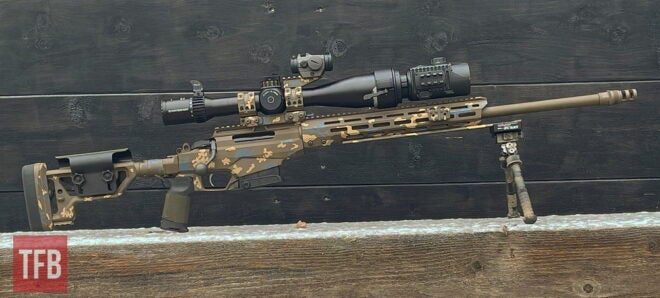
Tikka T3x TAC A1 with Schmidt & Bender 5-45×56 PMII High Power Riflescope and Pulsar Krypton Thermal Attachment
Background – The four-year review
Looking back at my notes, I feel embarrassed to see that I first started writing this review some four years ago. I guess that’s proof we all have limited time, but most of the explanation is actually that the rifle that the Schmidt & Bender 5-45×56 PMII was mounted on underwent more than one transformation. Processes that took a lot longer time than anticipated.
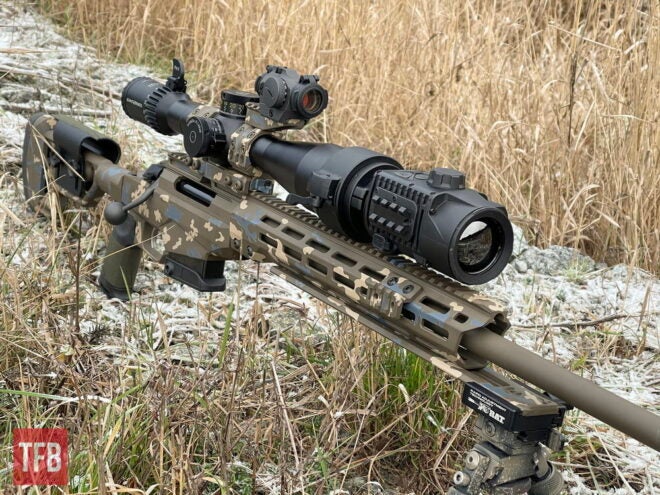
The rifle started out as a brand new Tikka T3x TAC A1 in 6.5 Creedmoor. A rifle that is more or less perfect out of the box. But you know the story, if we can modify something let’s go for it! As the Swedish Army was looking for a new sniper rifle, they also specified a new color, which I wanted to match. So the the Tikka was sent to a gunsmith and certified Cerakoter. Long story short, it was quite difficult to match the same color as I wanted, and while the Cerakoating came out really well it did take a very long time.
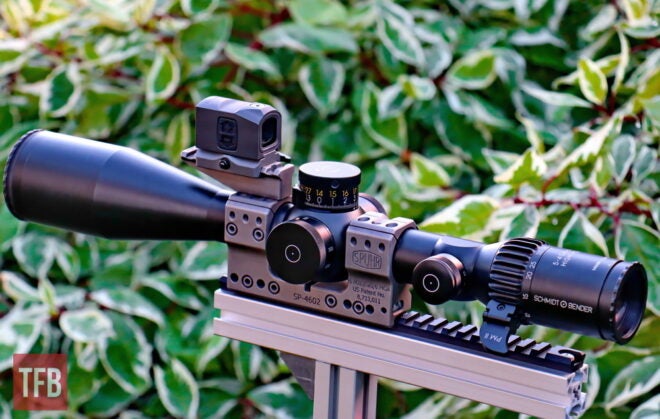
And about the time I got the original Cerakoted chassis, I needed a donor rifle for the Spuhr Ideal Chassis System, which started the journey from scratch.
The Setup
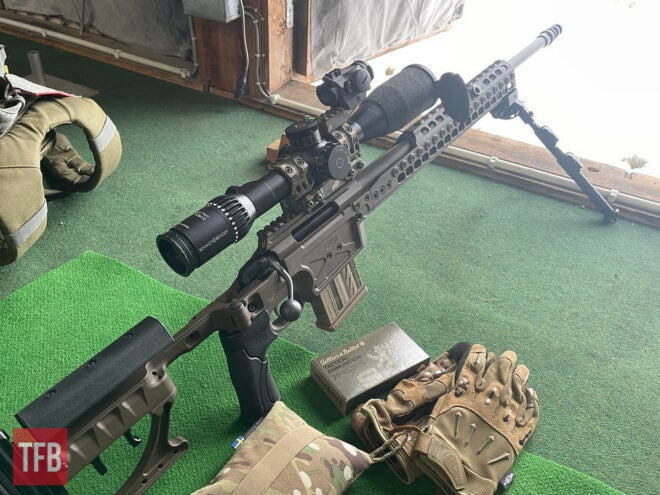
The setup can differ from image to image, due to the progress of the project, but basically, these parts are used here and there and links have been provided if you’re interested in learning more.
- Tikka T3x TAC A1 in 6.5 Creedmoor (originally black, but Cerakoted)
- Spuhr Ideal Chassis System – Modular Chassis System with Quick-Adjustable LOP and Recoil Pad Height. Cerakoted.
- Trigger – stock, but modified by a gunsmith.
- MDT LRA SEND iT – MV3 Electronic Level
- Aimpoint H-2 or ACRO C-1 Cerakoted
- Spuhr Mount SP-4602 – Overall a great mount, which you can depend on. Various accessories to attach red dots. Cerakoted.
- Apple Watch Ultra – with Strelok Pro.
- Thermal Front Attachment – Pulsar KRYPTON FXG50
- Magazines – Tikka’s stock (which are so so), and MDT‘s AICS with steel lip, which are great, to fit the Spuhr chassis.
- Various: Magpul ARCA rail, B&T Atlas Bipod, MDT Lightweight CkyePod (RRS BTC – Doublepull Legs).
- 5-45×56 PM II High Power LP UPC 191992061961 GR2ID 1cm CW DT II+ MTC LT. p/n: 666-911-422-L8-I6
- S&B Throw Lever PM II – p/n: 971-06840
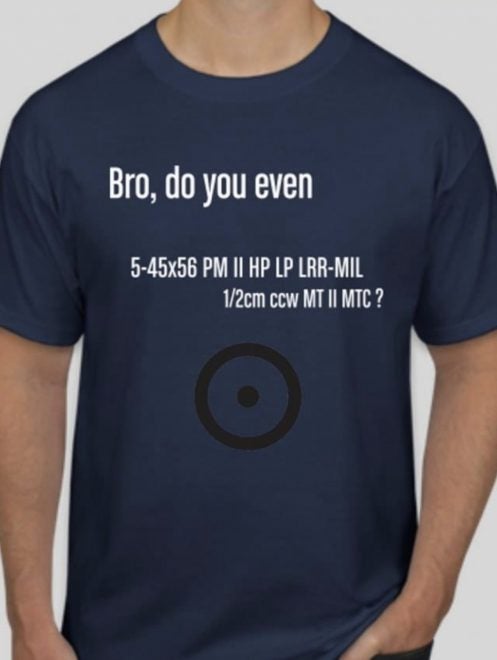
Here are some of the codes that S&B are using:
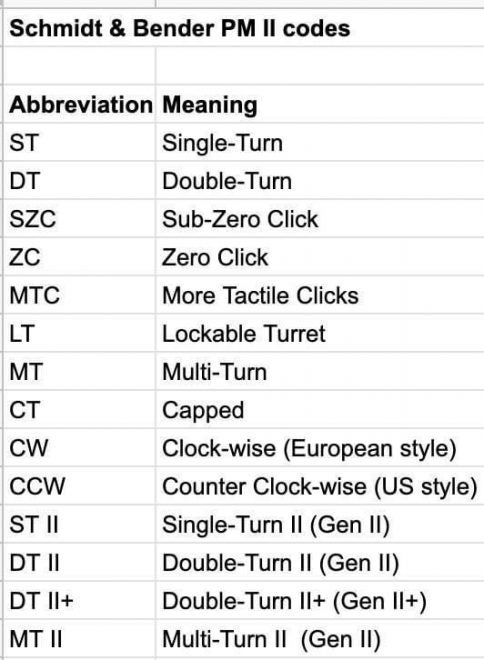
Behind the rifle and the scope
About two years ago I attended a field shooting at a military shooting range. Basically, you shoot 5 rounds at 100 meters, 200, 300 meters, etc., all the way up to 600 meters. I was not 100% on my settings, but I remember calling my own shots through the scope at 300 and 400 meters and could adjust accordingly.
Note that the images are from other occasions.
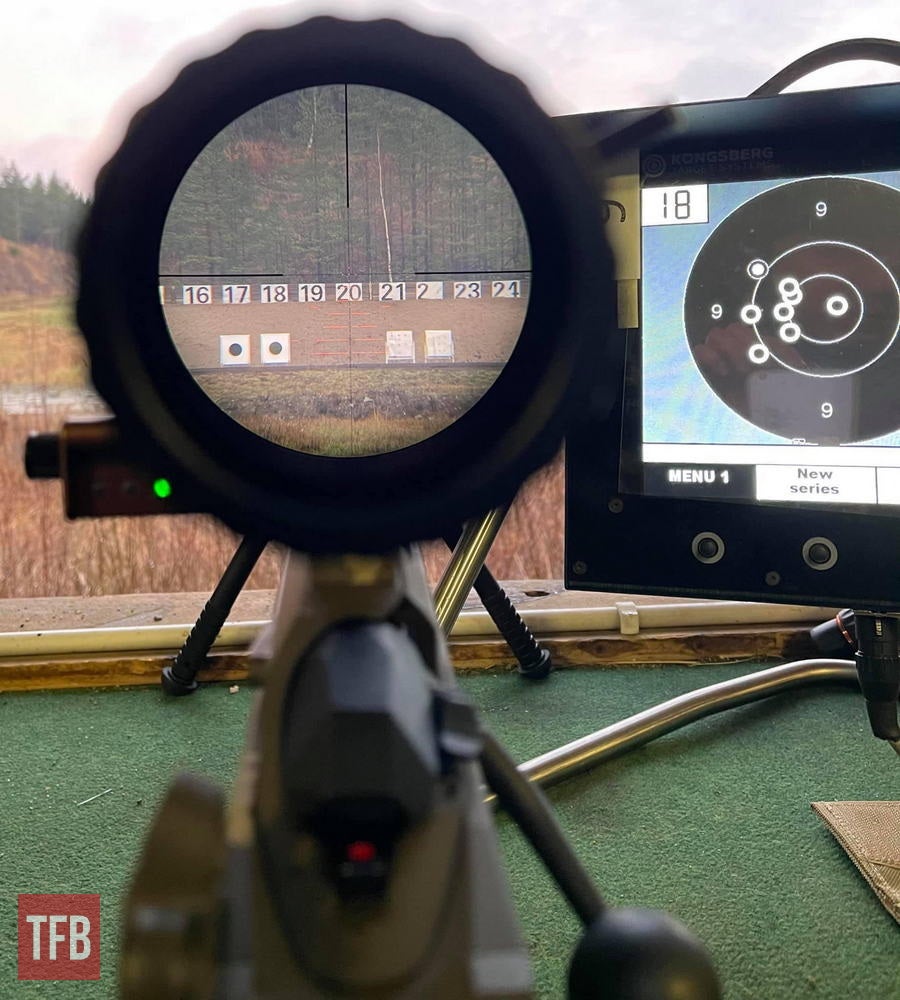
In a competition where more or less all of the participants hit all of the 30 shots in the 10, and the winner is the one who has the most inner-tens, I’d say it was quite useful to be able to adjust a click to the right. I think I ended up in the top 1/3, but it could be due to selective memory.
Depending on the conditions, it’s sometimes possible to see bullet holes on paper at medium distance in almost any optic. But the 5-45x does it better than anything I’ve ever tried, and at longer distances. Due to the winter, we have very poor daylight, and just a few weeks ago I was still able to call my own hits at 300 meters unless I hit directly in a black patch with the 6.5 Creedmoor.
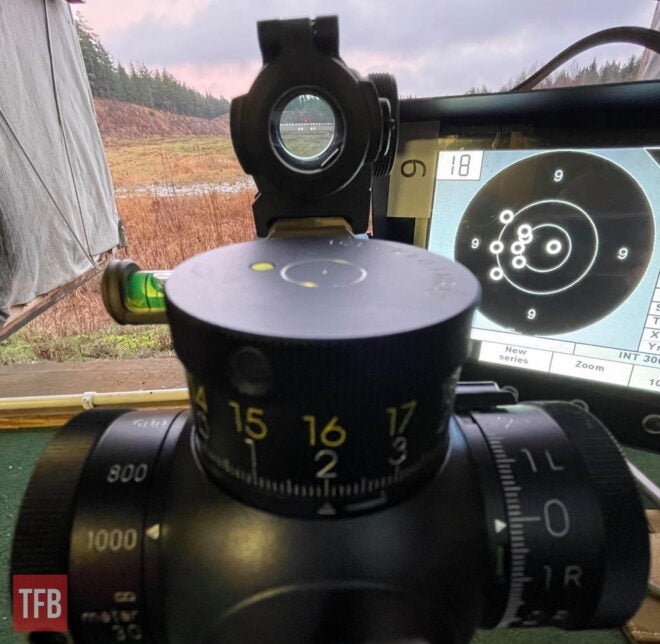
This is why you should have a red dot on top, to be able to switch between targets at 1x, and then line up before you look down in the magnified scope.
In another event, we were invited to shoot at a moving steel target going back and forth at about 600 meters. The target wasn’t large at all, more like a taller IPSC shield, but not as wide. We calculated and dialed for wind, at about 7 m/s, and held manually for speed as the target went both right to left. I’ve never done anything like this, but I was surprised how often I was able to hit given the difficulty.
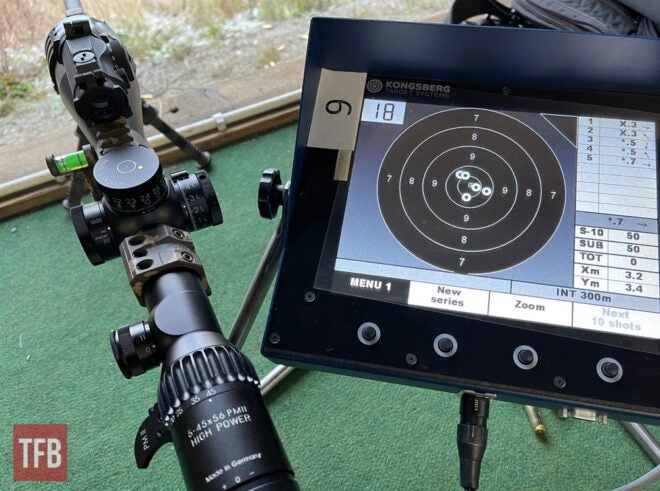
The parallax goes from 30 m up to infinity and is engraved with a meter index in order to give you an estimate of which distance you are looking at.
There’s for sure enough Field Of View (FOV) in the 5-45x for this. If I remember correctly, we held about 38 Mils ahead of the target (1 MRAD or MIL is 1 cm at 100 meters, so 228 cm at 600 meters), so being able to swivel smoothly around the bipod was important. This event was also in a military shooting area, and adjacent to us there were soldiers learning how to throw hand grenades making the overall experience quite exciting, to say the least.
Below: International 300 meter targets ISSF, in snowfall.
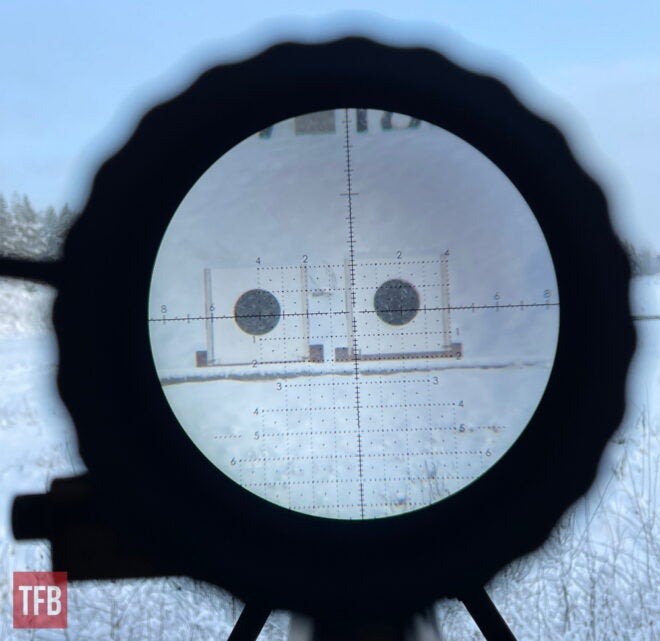
Note the MDT LRA SEND iT – MV3 Electronic Level ($299.95), which gives you instant visible feedback. This is a great product, and highly recommended.
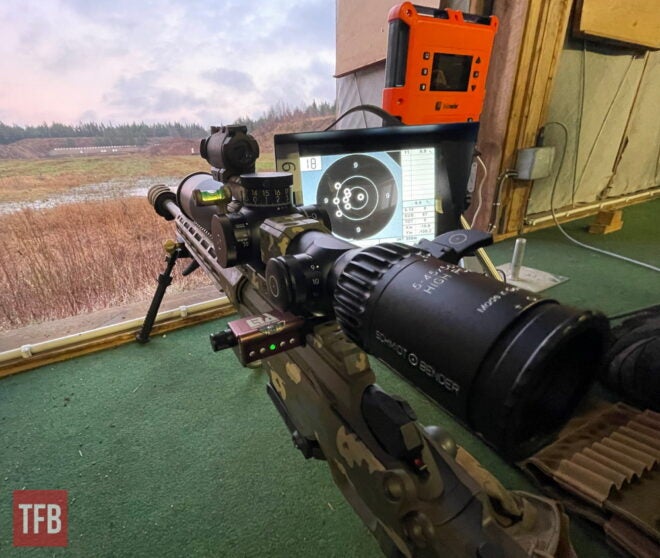
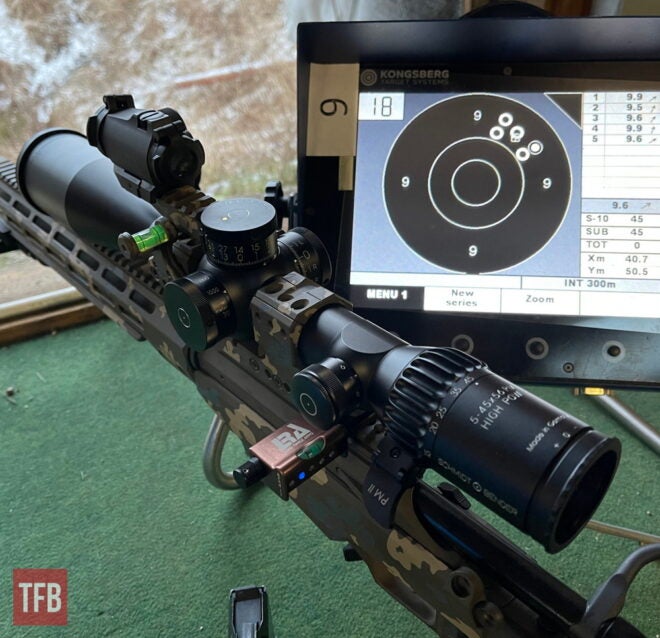
Optics & Reticle
Considering how extreme the 5-45x can go in terms of magnification, it’s incredible how sharp and crisp the image is. The reticle I use is called: GR²ID (FFP). Would any of the other reticles be more suitable? Well, it depends on your needs. The LRR-MIL (FFP) would probably be my choice if I did a lot of extreme long-range shooting, which I don’t.
Here’s the “map” to read the reticle. Notice that the “CAD” from S&B is much more obtrusive than it appears in real life on the higher magnifications.
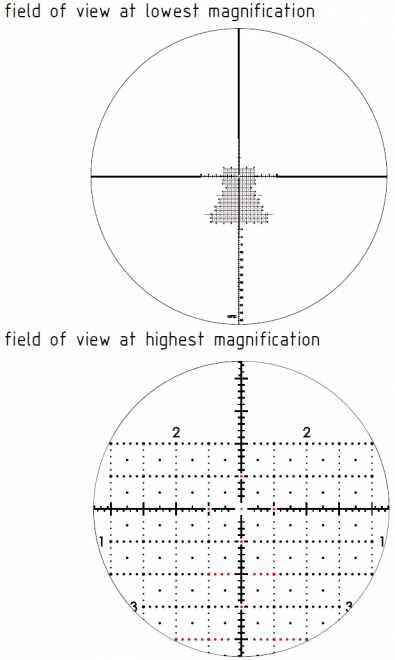
This is how to read the GR²ID reticle. It can be downloaded from S&B’s website for details.
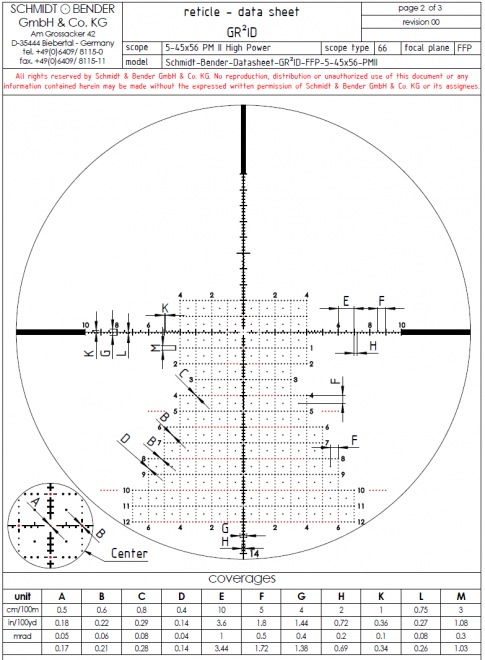
There’s no better way to explain these things than with images. Just consider that images probably can lie more than words sometimes, due to exposure and other factors. Taking quality images of reticles is really difficult.
These chimneys are about 1250 meters away.
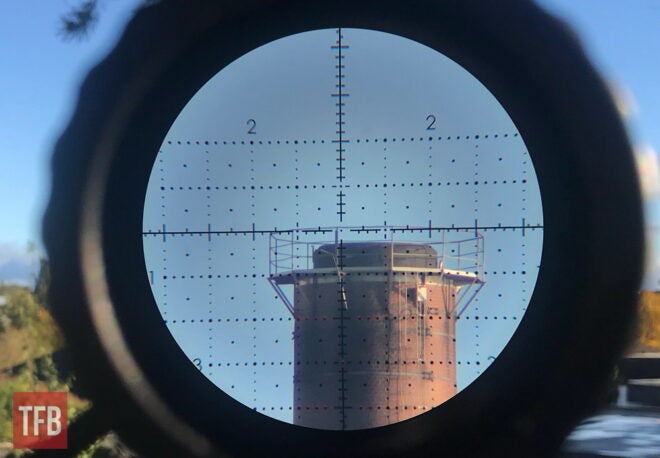
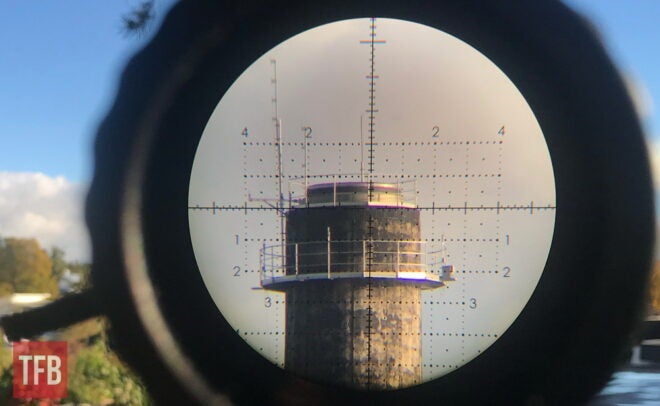
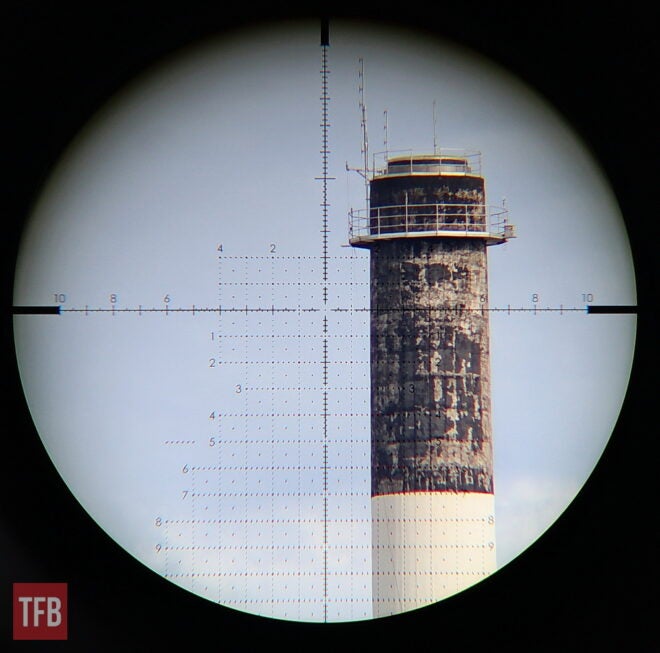
Did you know that illuminated reticles were prohibited in Germany until 1996?
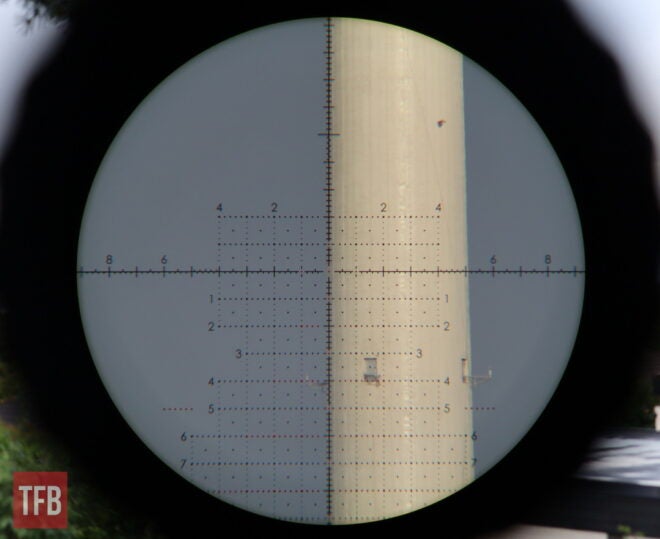
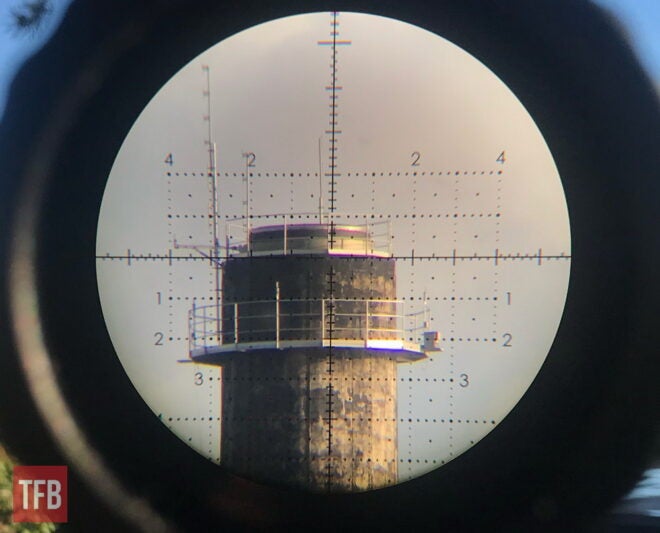
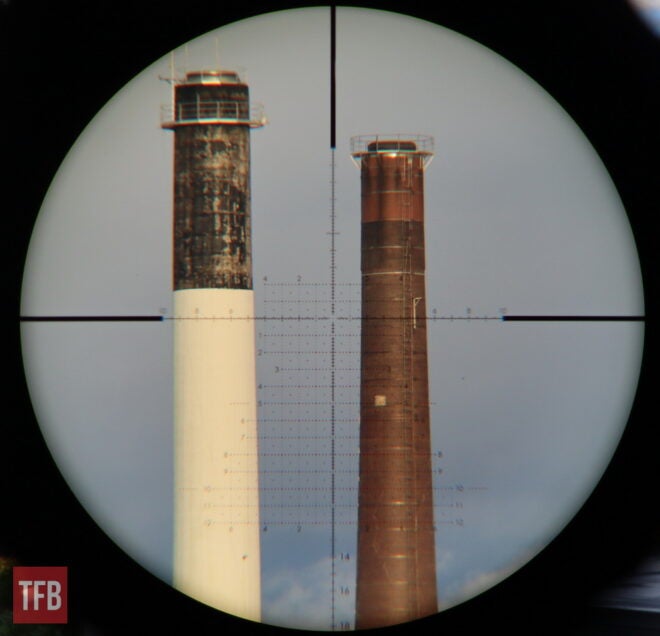
At 1250 meters or about 3/4 of a mile, I can actually take a fairly detailed look at the flashing light that warns airplanes of the chimneys (bottom right). The more I think of it, the more impressed I get. Illumination of the reticle is also visible. The below image is cropped on my computer. Here there’s some CA, but I didn’t really notice as I was watching it live.
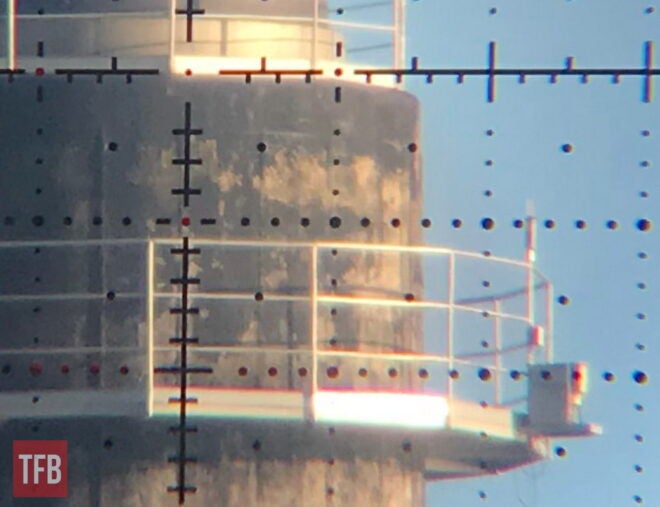
Mother nature also offers some interesting “targets”, fir cones at about 300 meters.
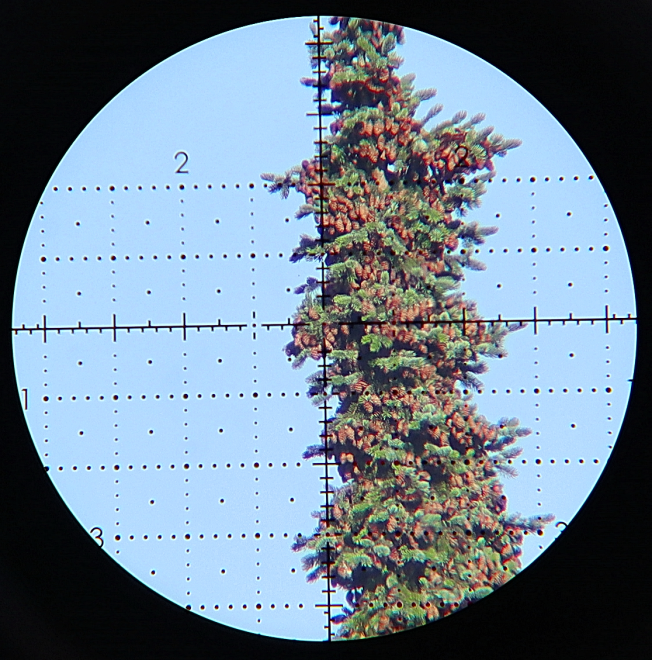
These images are from four years ago when I just got the 5-45. I had an opportunity to visit the great outdoors and took some sample images of the (relative) wilderness.
Below: The camera has an issue recording the telecom mast, so the finger points it out.
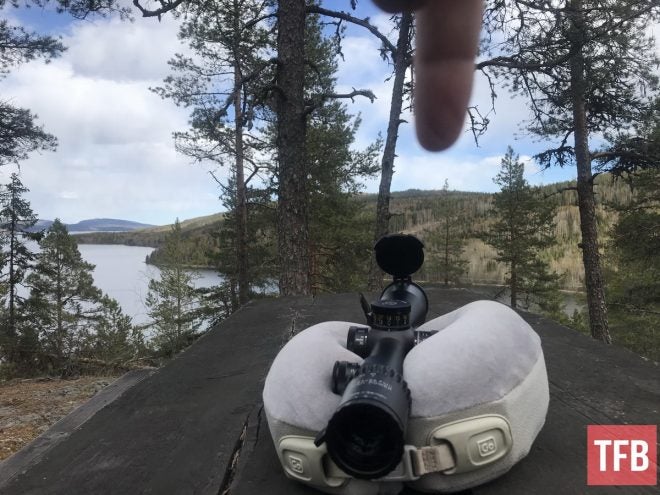
There’s a hint of it in this picture.
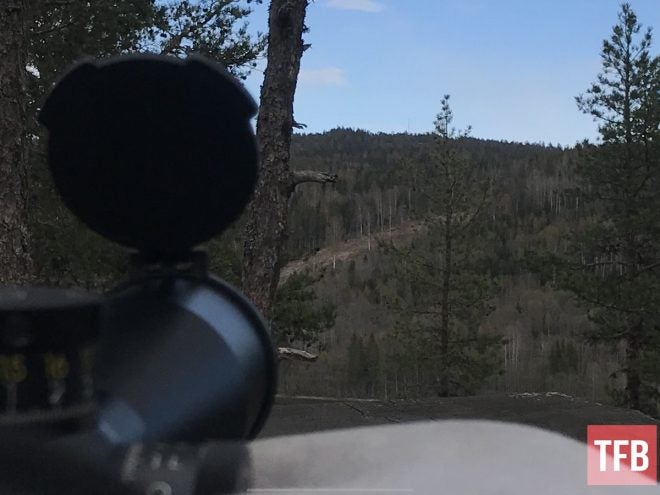
But with the 5-45x we have no issues seeing the telecom mast (it’s hidden in the middle of the reticle).
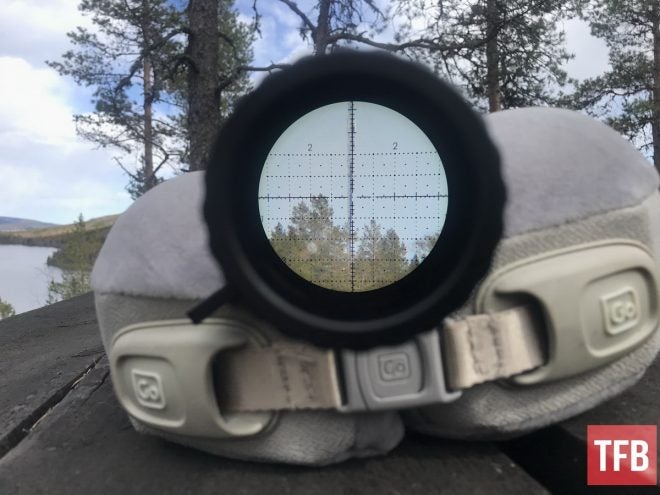
Google Earth says about 2000 meters, and it could be that the parallax is a little bit out.
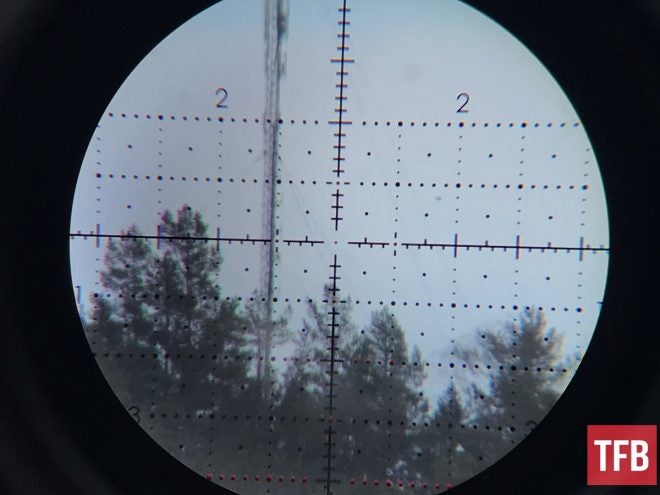
As you can see, the scope is not mounted to a rifle, but it’s possible to do pretty good observations of what going on far away. I can see why the Special Forces specified this kind of optical device. Distance is about 3000 meters, and this is not at full zoom.
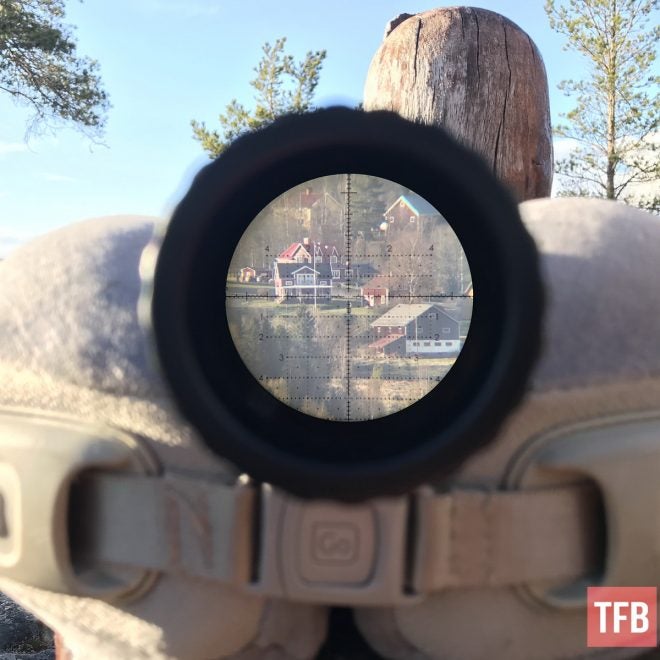
The camera does play a factor in how the image looks, and getting the camera perfectly aligned with the optical system of the scope is always a challenge.
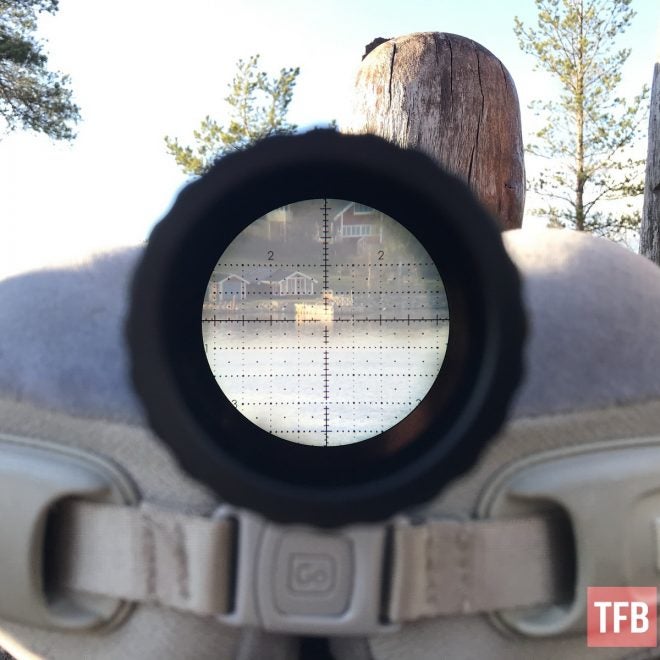
The distance to this road crossing is about 2800 meters.
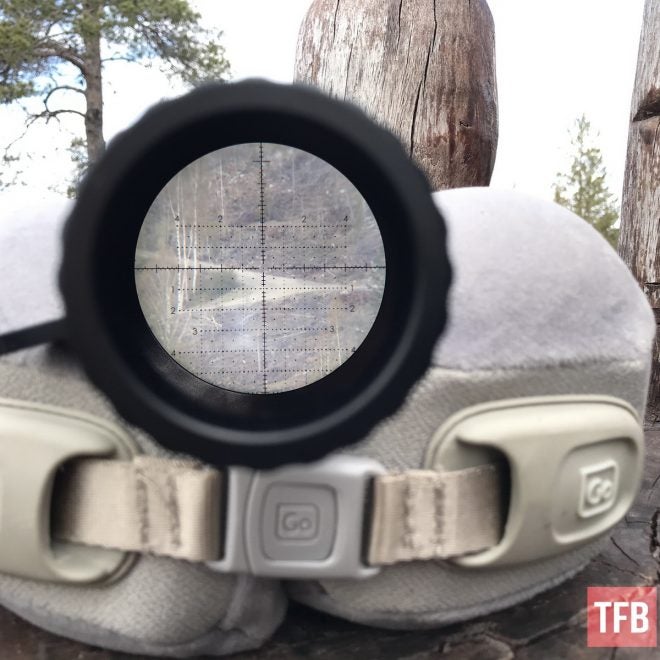
And it’s still possible to zoom in a little bit more, but beyond 35x you lose a bit of clarity.
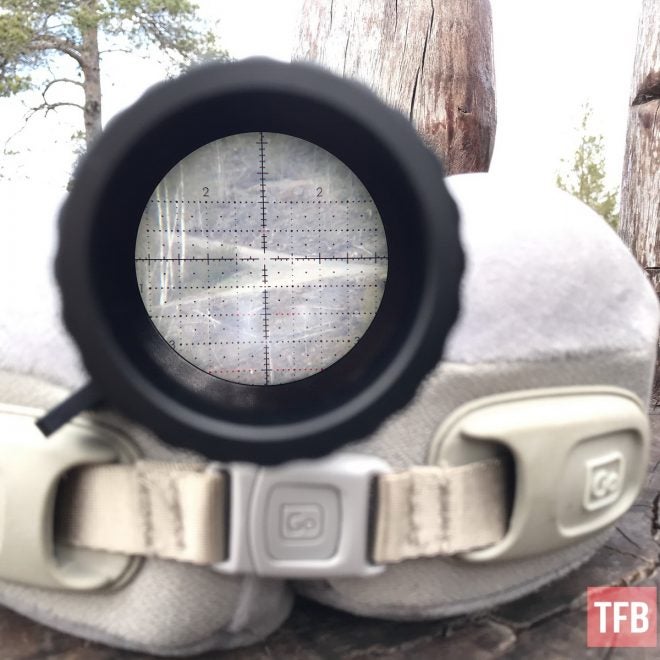
This is on fairly low magnification, unknown distance but probably 3000+ meters.
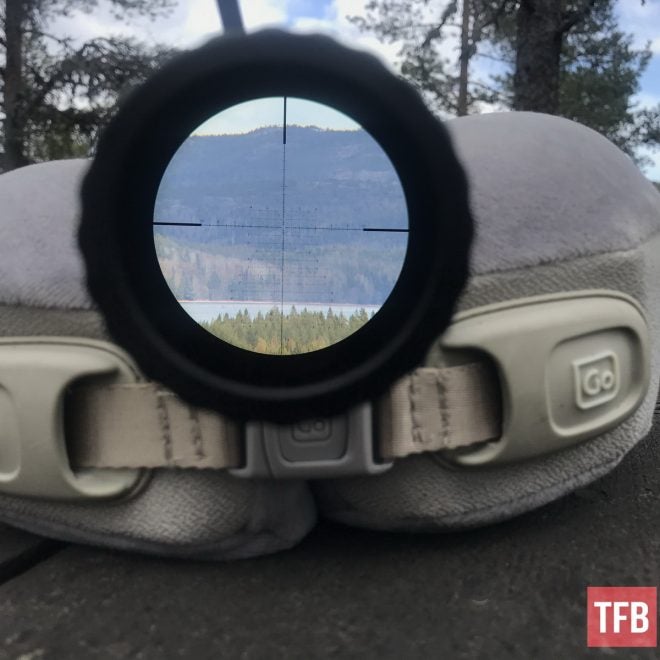
One of the issues with taking photos is the reflections from behind and within. Your camera would rather capture the reflections, than the target you’re looking at. It’s not S&B’s fault and other optics have the same issues. I’ve tried several methods to get rid of it, eventually, I’ll get there I hope.
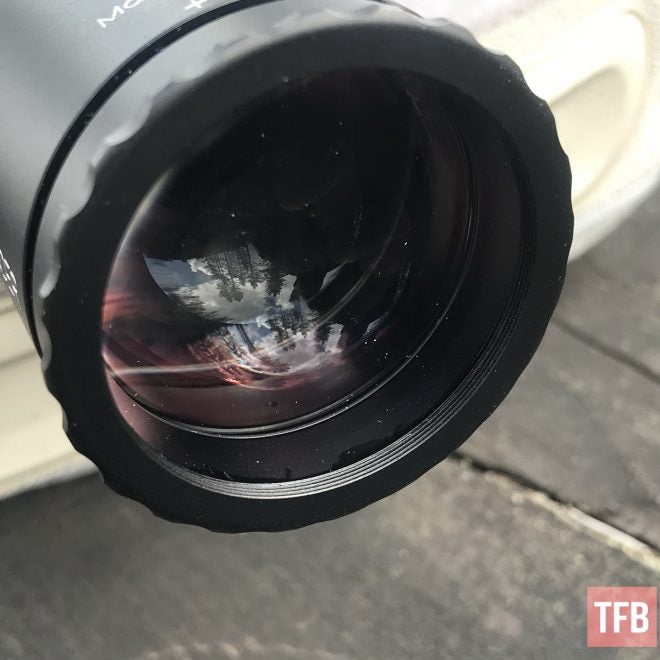
Nice bird. 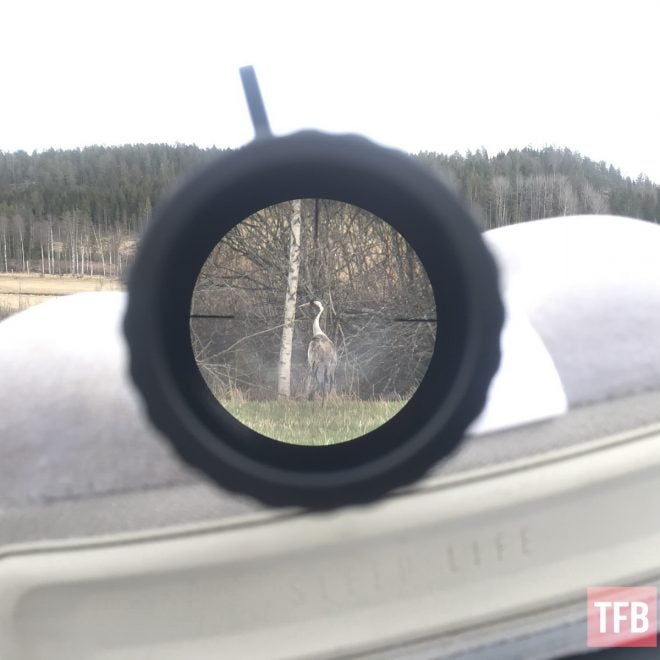
If my Google Earth-fu is correct, the farthest mountain is about 8+ kilometers away. Unfortunately, none of the 35-45 power pictures turned out well, and I only noticed when I got home. But I was able to pin-point out single trees at about 10 kilometers, much further than any of my rifles would shoot.
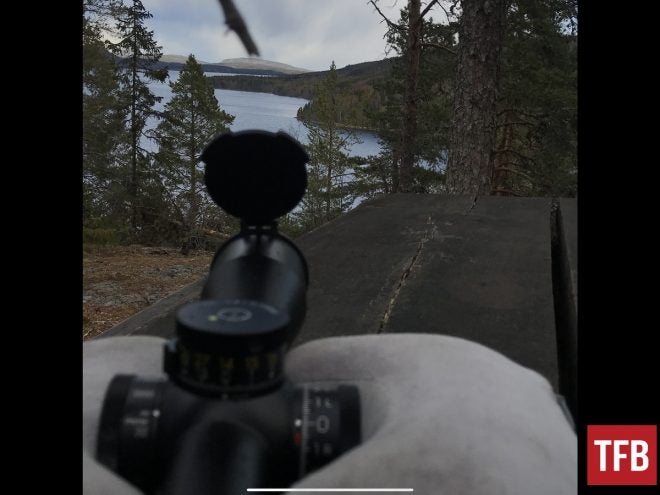
The 5-45x uses a latheral LED Illumination for the reticle.
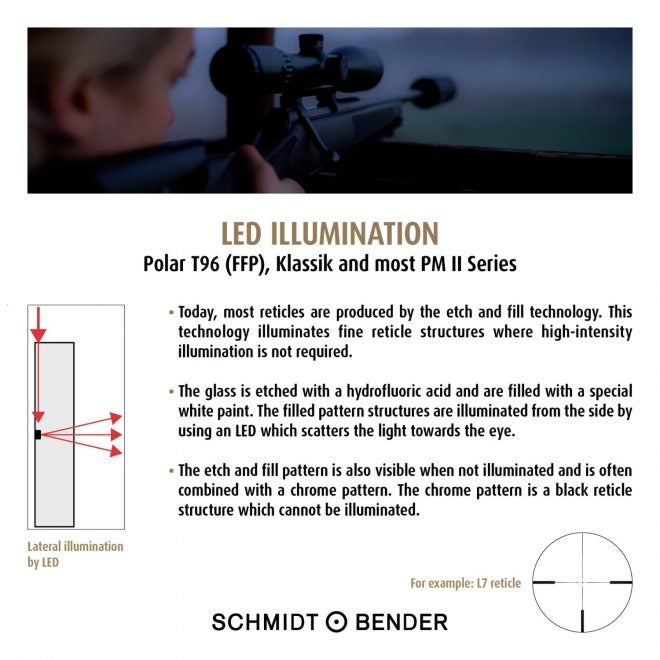
Image: Schmidt & Bender
Some facts about the 5-45x PMII
A few months ago I had the opportunity to stop by at Schmidt & Bender in Biebertal, Germany. The 5-45×56 High Power is made out of 240 single parts, with most of the material made out of stainless steel. This involves all screws, which are quite important since they have to take all the G forces without ever breaking. The second most used material is aluminum. Plastic is the material which is used the least, at about 2%. There are about 20 O-rings that get the scope waterproof and also down to an extreme -46C. The “glass” content is below 10% but stands for over 20% of the overall weight. Each turret is fitted individually by S&B’s technicians to guarantee a crisp adjustment and smooth locking function. Each and every riflescope is really hand-built to your order.
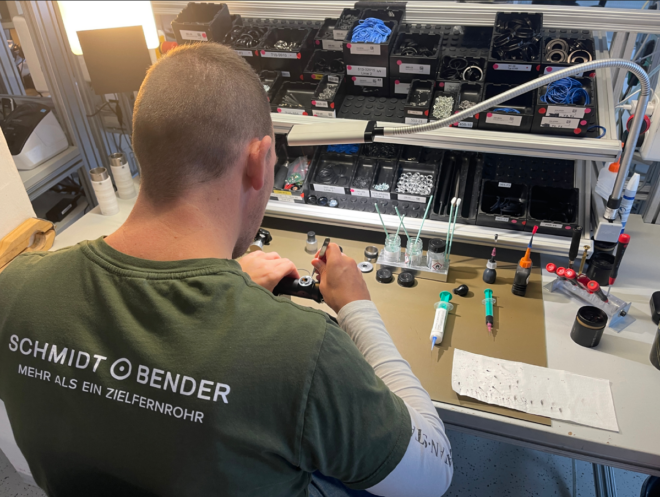
5-45x HIGH POWER – Technical Specifications
- Weight: 1106 g
- Length: 434 mm
- Main tube diameter: 34 mm
- Magnification: 5.0 – 45.0
- Objective diameter: 56 mm
- Field of view 7.8 m – 0.9 m / 100 m
- Exit pupil: 8.8 mm – 1.2 mm
- Eye relief: 90 mm
- Twilight factor: 16.7 – 50.2
- Transmission: 90 %
- Focal plane: 1st
- Adjustment range elevation turret: 270 cm / 66 MOA
- Adjustment range windage turret: ± 60 cm / ± 15 MOA
- Parallax: 30 m – ∞
Apple Watch Ultra and Strelok Pro ballistic calculator
Just playing around to show what’s available (in some markets).
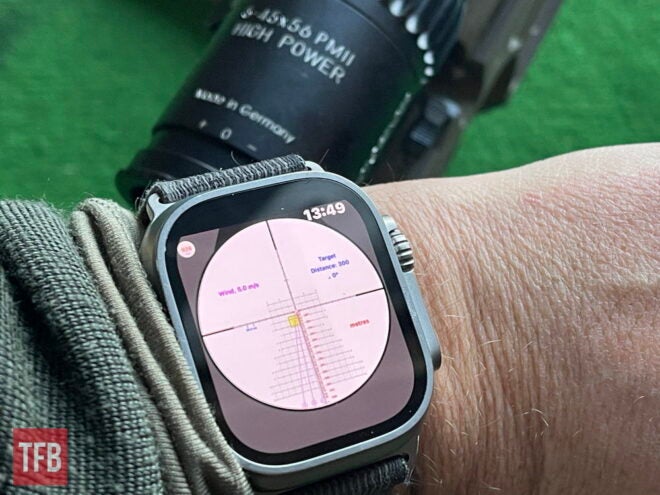
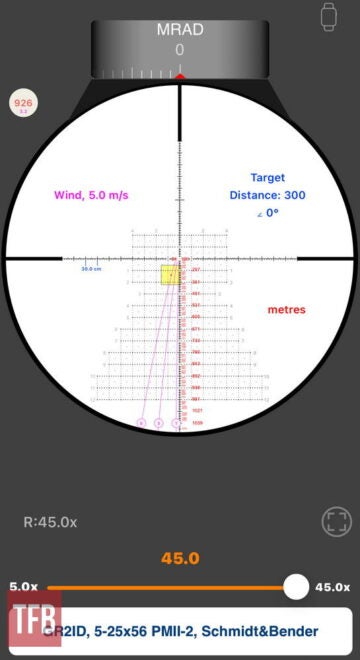
The setup – as of late
As mentioned, I ditched the original Tikka chassis and replaced it with the new Spuhr Ideal Chassis System.
Two beasts side-by-side. The S&B 5-45x is closest, and the Zero Compromise ZCO840 is in the back. Don’t get me wrong, these two optics are excellent but it feels like S&B is built to obtain military contracts while the other is more to compete in the upper Precision Rifle Series market segment – but let’s see what the future has in sight for these brands. The black rifle is a Bartlein barreled 6XC, Rem 700 action BAT Machine and a 9 mm suppressor, also in a Spuhr SICS chassis.
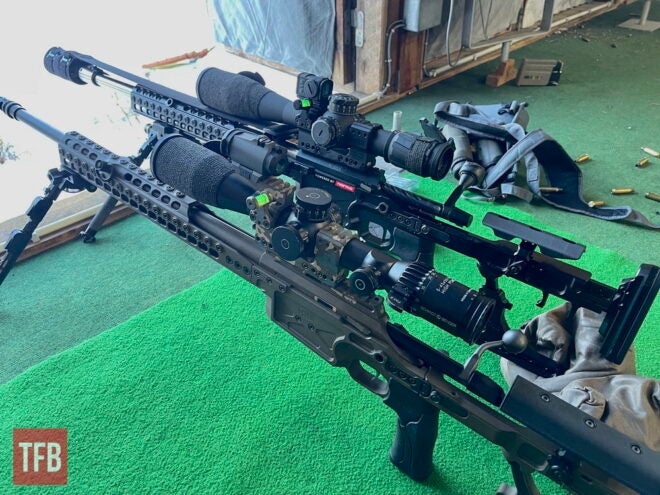
While the mount is the same, the chassis is now made by Spuhr and this is how the rifle will now stay.
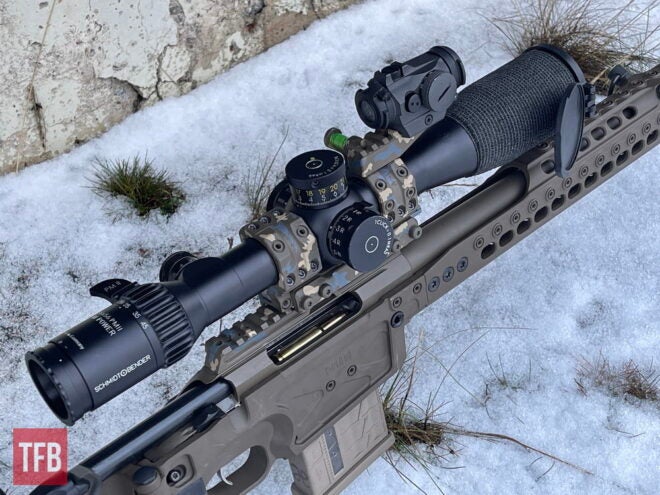
Note the MDT Lightweight CkyePod (RRS BTC – Doublepull Legs), which is by far the most stable bipod I’ve ever used. It’s no wonder these bipods are used by so many PRS shooters.
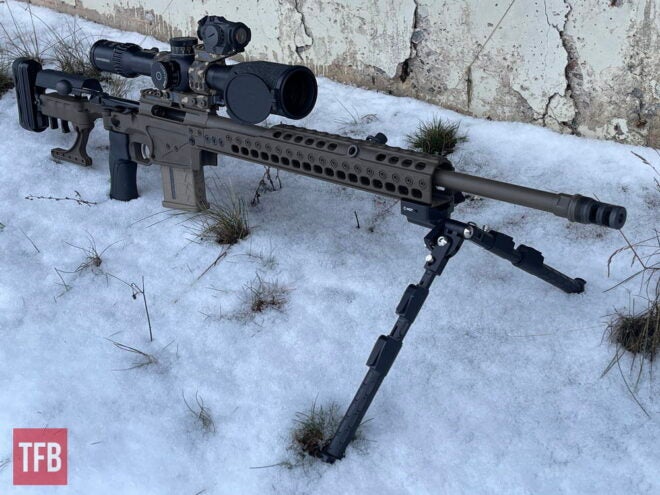
Shooting the Tikka T3x TAC A1 in a Spuhr chassis. The Swedish Army has now selected their next sniper rifle, the Sako TRG M10 but in the same color as shown here.
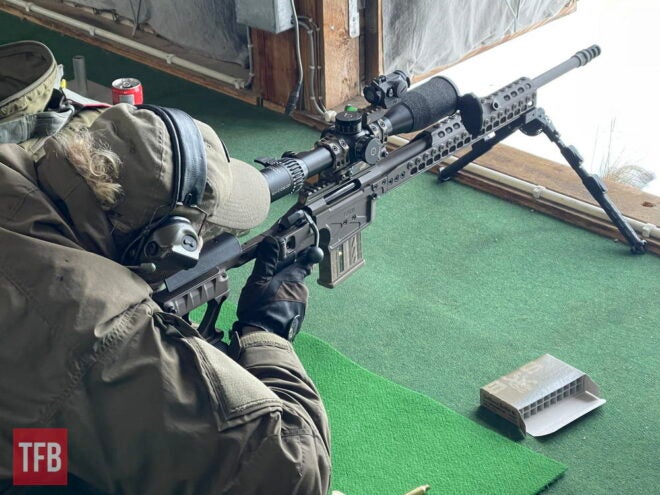
Note the MDT magazine, which I recommend for the Spuhr chassis (it won’t take the Tikka magazines).
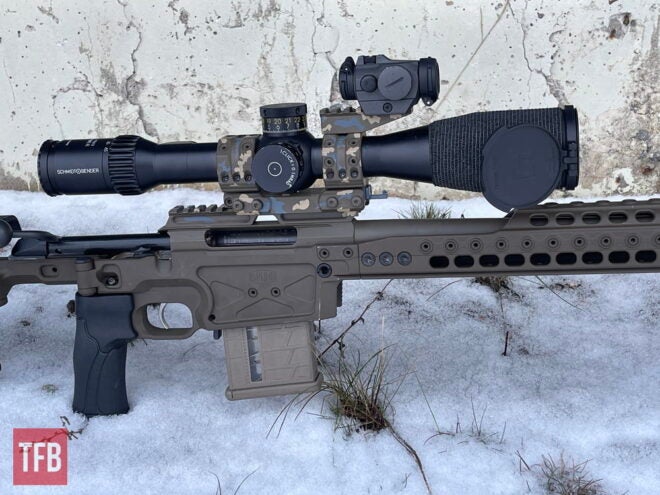
Zeroing using the Kongsberg electronic targets at 300 meters, which provide instant feedback. The green light from the MDT shows the shooter that the rifle is leveled.
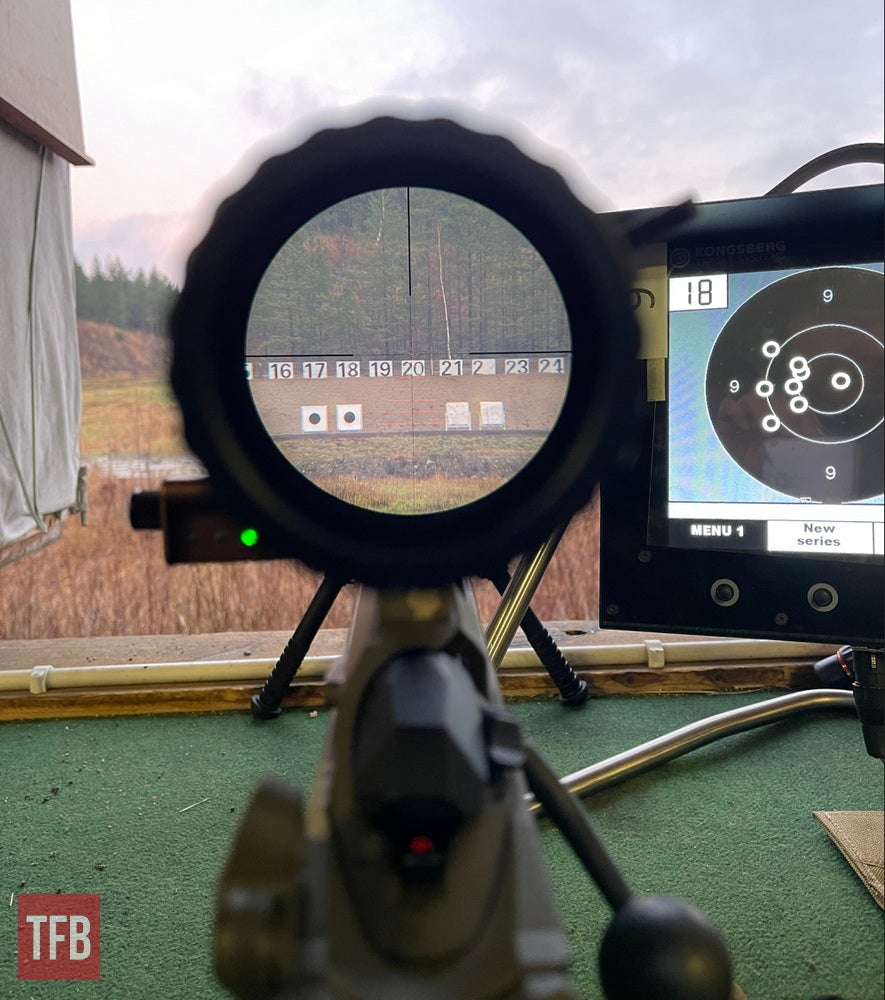
The box in the middle marks the mathematical center of the 5 bullets. Pretty centered I’d say, and probably a personal best.
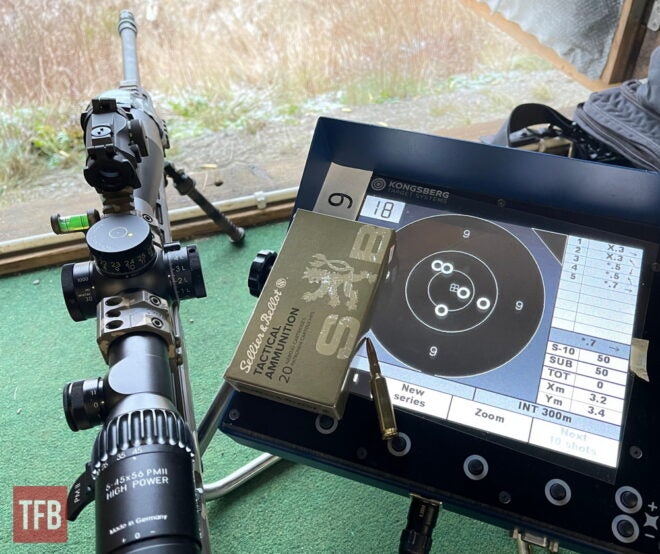
Shooting suppressed (ASE Utra) at 300 meters.
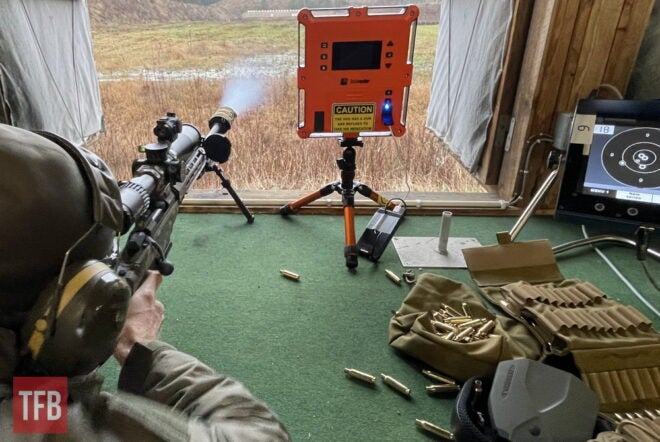
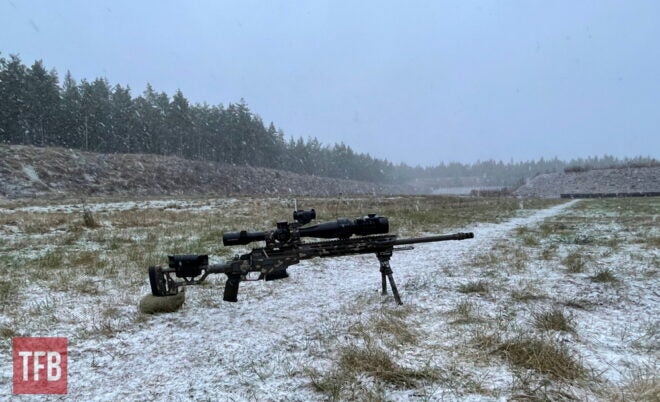
Spotting the targets by drone. Have you ever tried it?
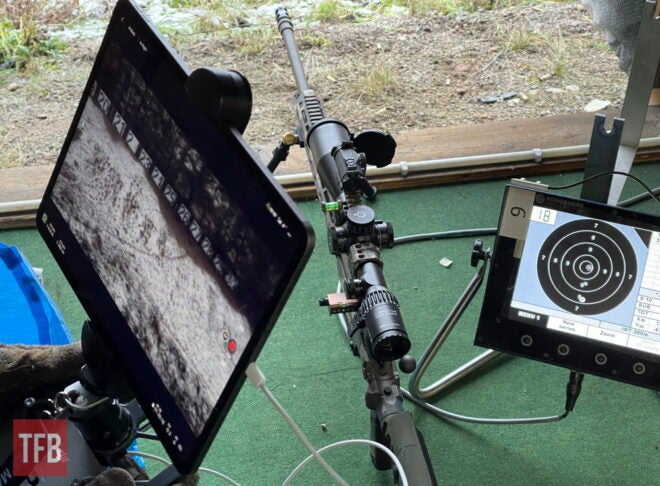
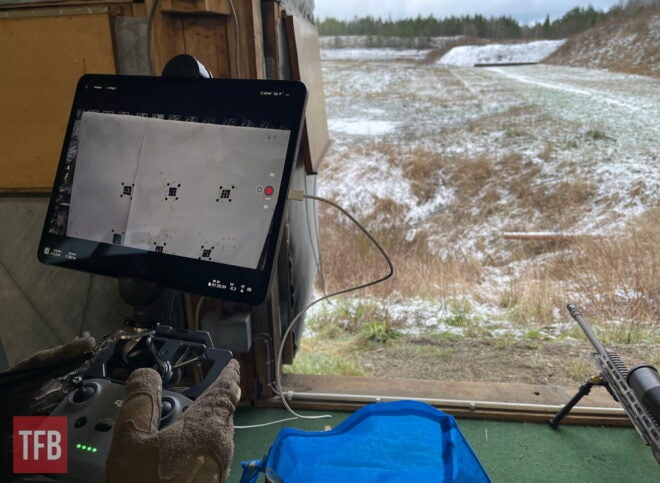
I did play with a thermal clip-on. While the 5x minimum is a bit too high, it still works, but I would recommend a riflescope more in the region of 2-6 power. This Pulsar Krypton has now been replaced by the Krypton 2 models.
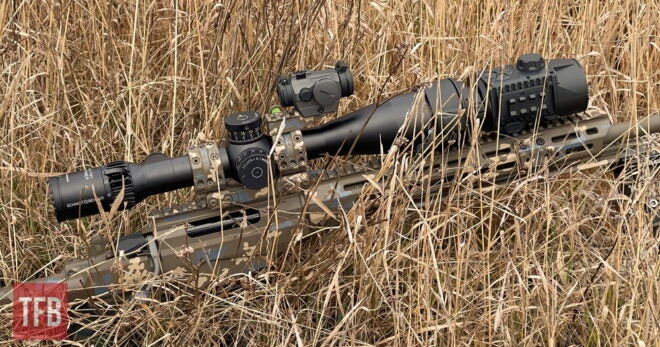
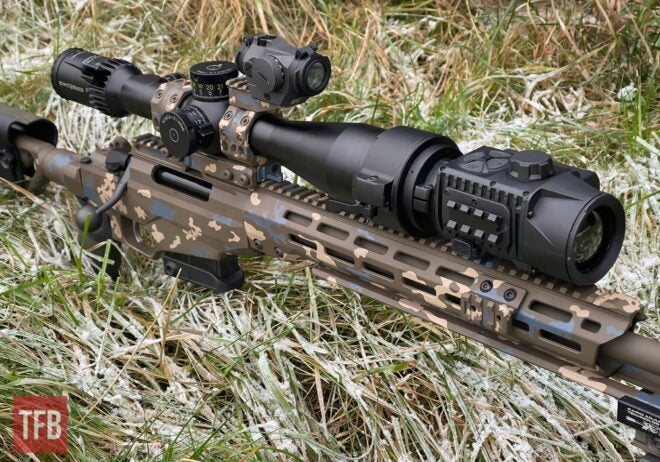

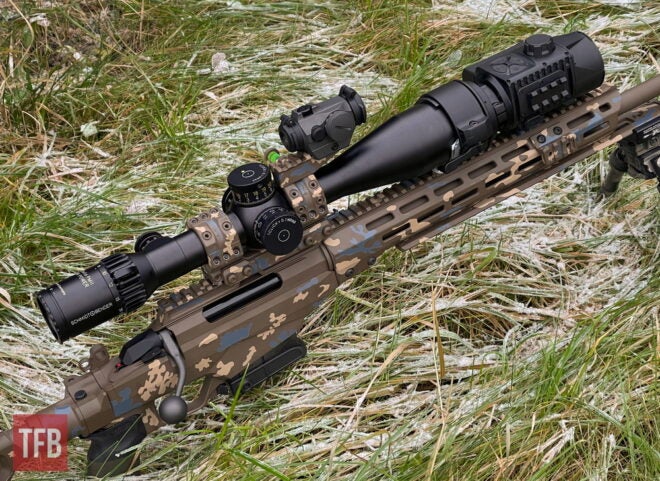
The eye in the sky, thermal clip-on.
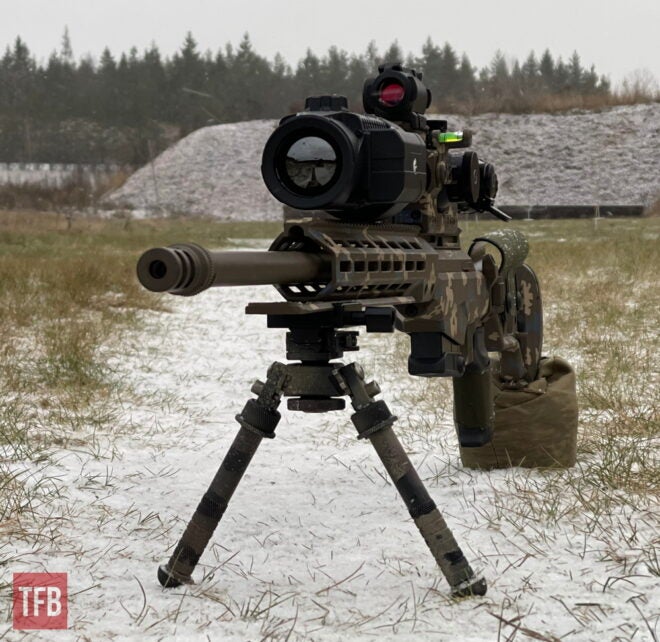
Hitting steel with the GRID reticle, 300 meters.
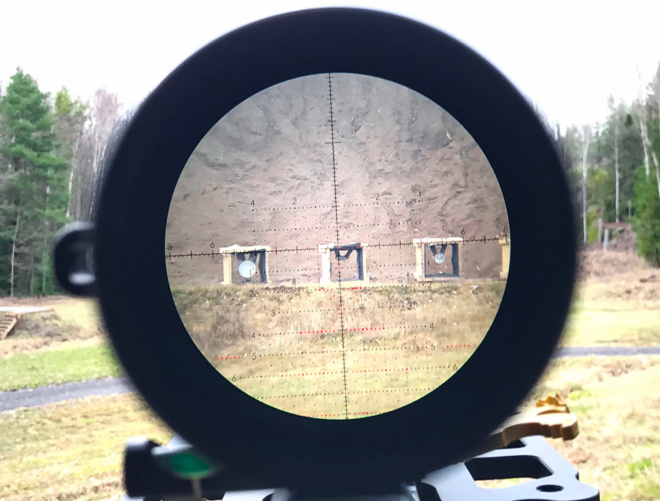
The high power collection.
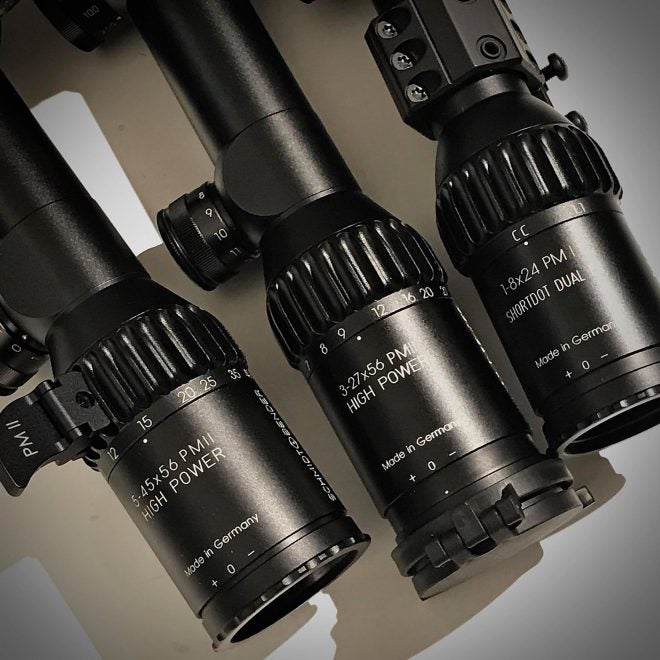
Schmidt Bender 5-45×56 is the top of the line.
Just as a reminder, you can really do some amazing “zoom-ins” on various objects like the ornament on this house and the cable connection. The distance is about 250 meters, scope is not mounted to a rifle.
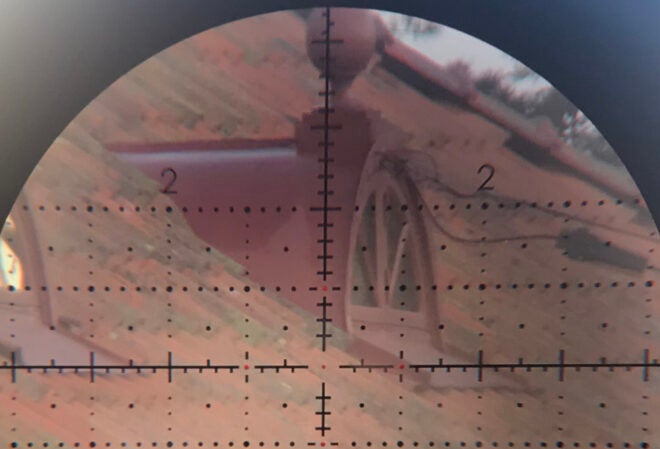
Coming to a conclusion
For practice and accuracy, I find myself using the maximum 45x magnification a lot more often than expected. For PRS competition that kind of extreme magnification is too much, and I need the FOV instead. The 30-45x range is a nice option to have, and quite often I’m able to spot details others can’t, just by cranking up the magnification.
A stable shooting position is of course needed, but the eyebox is more forgiving than you’d expect. The downside of this kind of optic is mainly the size, as in the length of 434 mm/17.09″ and the weight of about 1.1 kg. Then there’s the price.
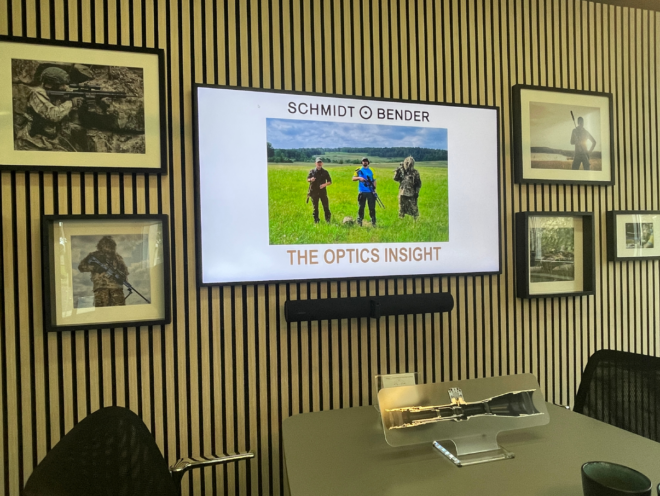
From Schmidt & Bender HQ in Germany. Note the riflescope cut in half. S&B runs competition, hunting and Police/Military product lines.
There are a number of reasons to like this optic, such as the overall ergonomics, the robust design, and mechanical accuracy in the turrets (clicks, and lockable) and magnification ring. It’s easy to zero, has many reticle choices, and an extreme magnification range without tunneling. There are so many options to configure, so you get exactly what you want.
Below: Shooting using the upper magnification is like cheating, even in the snow.
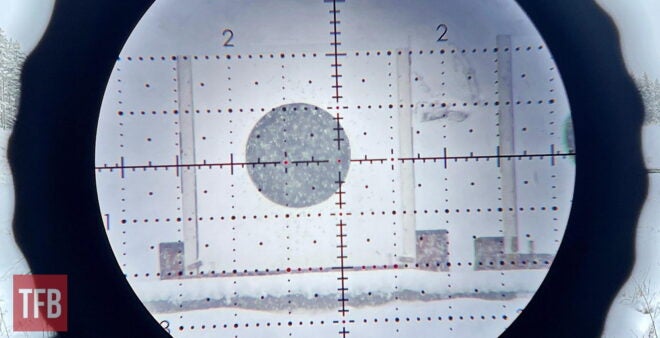
S&B 5-45x at maximum power, with lots of snow in the air.
The 5-45x PMII is definitely a bit overkill for my rifle (in 6.5 Creedmoor) and my needs, but I still love it. It’s a bit like the Marshall speakers in the movie This Is Spinal Tap (1984) that go to eleven instead of ten – “it’s one louder“.
It was expensive but I don’t regret buying my Holy Grail. It’s even more expensive now, so can we agree that I saved some money?
As the USSOCOM now goes looking for an Extreme Long Range-Sniper Rifle, I know in which direction I’d point them if they were to ask me for a suitable optic. The 5-45x is a special optic for special needs.
However, the new Schmidt & Bender 6-36×56 PM II, which arrived for testing a few months ago, would probably take care of most of my personal needs and well beyond, and at a lower price. It’s doing pretty well so far.
You can find out more here: 5-45×56 PM II High Power.
 Your Privacy Choices
Your Privacy Choices
